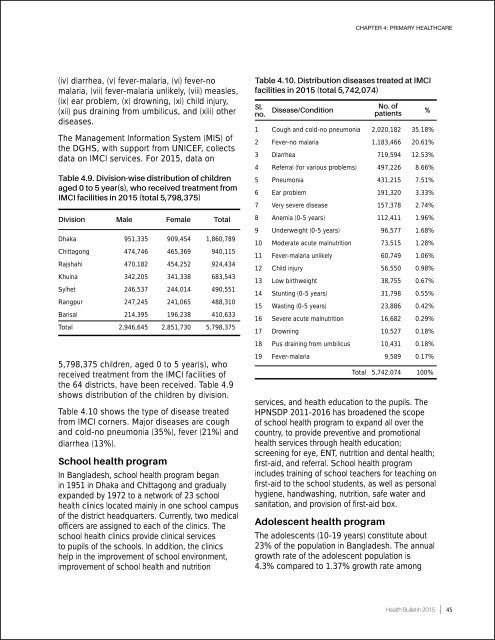1otPoKy
1otPoKy
1otPoKy
Create successful ePaper yourself
Turn your PDF publications into a flip-book with our unique Google optimized e-Paper software.
CHAPTER 4: PRIMARY HEALTHCARE<br />
(iv) diarrhea, (v) fever-malaria, (vi) fever-no<br />
malaria, (vii) fever-malaria unlikely, (viii) measles,<br />
(ix) ear problem, (x) drowning, (xi) child injury,<br />
(xii) pus draining from umbilicus, and (xiii) other<br />
diseases.<br />
The Management Information System (MIS) of<br />
the DGHS, with support from UNICEF, collects<br />
data on IMCI services. For 2015, data on<br />
Table 4.9. Division-wise distribution of children<br />
aged 0 to 5 year(s), who received treatment from<br />
IMCI facilities in 2015 (total 5,798,375)<br />
Division Male Female Total<br />
Dhaka<br />
Chittagong<br />
Rajshahi<br />
Khulna<br />
Sylhet<br />
Rangpur<br />
Barisal<br />
Total<br />
951,335<br />
474,746<br />
470,182<br />
342,205<br />
246,537<br />
247,245<br />
214,395<br />
2,946,645<br />
909,454<br />
465,369<br />
454,252<br />
341,338<br />
244,014<br />
241,065<br />
196,238<br />
2,851,730<br />
1,860,789<br />
940,115<br />
924,434<br />
683,543<br />
490,551<br />
488,310<br />
410,633<br />
5,798,375<br />
5,798,375 children, aged 0 to 5 year(s), who<br />
received treatment from the IMCI facilities of<br />
the 64 districts, have been received. Table 4.9<br />
shows distribution of the children by division.<br />
Table 4.10 shows the type of disease treated<br />
from IMCI corners. Major diseases are cough<br />
and cold-no pneumonia (35%), fever (21%) and<br />
diarrhea (13%).<br />
School health program<br />
In Bangladesh, school health program began<br />
in 1951 in Dhaka and Chittagong and gradually<br />
expanded by 1972 to a network of 23 school<br />
health clinics located mainly in one school campus<br />
of the district headquarters. Currently, two medical<br />
officers are assigned to each of the clinics. The<br />
school health clinics provide clinical services<br />
to pupils of the schools. In addition, the clinics<br />
help in the improvement of school environment,<br />
improvement of school health and nutrition<br />
Table 4.10. Distribution diseases treated at IMCI<br />
facilities in 2015 (total 5,742,074)<br />
Sl.<br />
no.<br />
1<br />
2<br />
3<br />
4<br />
5<br />
6<br />
7<br />
8<br />
9<br />
10<br />
11<br />
12<br />
13<br />
14<br />
15<br />
16<br />
17<br />
18<br />
19<br />
Disease/Condition<br />
Cough and cold-no pneumonia<br />
Fever-no malaria<br />
Diarrhea<br />
Referral (for various problems)<br />
Pneumonia<br />
Ear problem<br />
Very severe disease<br />
Anemia (0-5 years)<br />
Underweight (0-5 years)<br />
Moderate acute malnutrition<br />
Fever-malaria unlikely<br />
Child injury<br />
Low birthweight<br />
Stunting (0-5 years)<br />
Wasting (0-5 years)<br />
Severe acute malnutrition<br />
Drowning<br />
Pus draining from umbilicus<br />
Fever-malaria<br />
Total<br />
No. of<br />
patients<br />
2,020,182<br />
1,183,466<br />
719,594<br />
497,226<br />
431,215<br />
191,320<br />
157,378<br />
112,411<br />
96,577<br />
73,515<br />
60,749<br />
56,550<br />
38,755<br />
31,798<br />
23,886<br />
16,682<br />
10,527<br />
10,431<br />
9,589<br />
5,742,074<br />
%<br />
35.18%<br />
20.61%<br />
12.53%<br />
8.66%<br />
7.51%<br />
3.33%<br />
2.74%<br />
1.96%<br />
1.68%<br />
1.28%<br />
1.06%<br />
0.98%<br />
0.67%<br />
0.55%<br />
0.42%<br />
0.29%<br />
0.18%<br />
0.18%<br />
0.17%<br />
100%<br />
services, and health education to the pupils. The<br />
HPNSDP 2011-2016 has broadened the scope<br />
of school health program to expand all over the<br />
country, to provide preventive and promotional<br />
health services through health education;<br />
screening for eye, ENT, nutrition and dental health;<br />
first-aid, and referral. School health program<br />
includes training of school teachers for teaching on<br />
first-aid to the school students, as well as personal<br />
hygiene, handwashing, nutrition, safe water and<br />
sanitation, and provision of first-aid box.<br />
Adolescent health program<br />
The adolescents (10-19 years) constitute about<br />
23% of the population in Bangladesh. The annual<br />
growth rate of the adolescent population is<br />
4.3% compared to 1.37% growth rate among<br />
| 45


